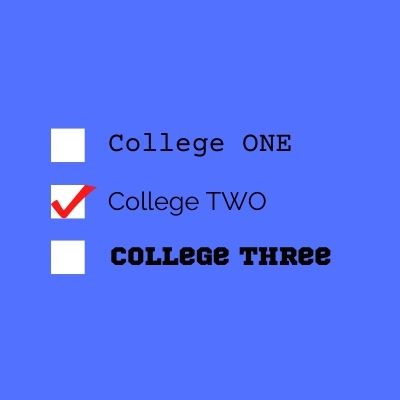Making the Final College Choice
Last Updated on February 17, 2024 by Jill Schwitzgebel
You’re on the homestretch of your teen’s senior year in high school. You’ve survived a tough year that likely included virtual and in-person college tours and time spent nagging about college essays, on top of your student’s usual academic load. Acceptances are beginning to roll in. Maybe more than even anticipated (yay!). Or maybe there was a rejection that surprised everyone (boo!). Either way, usually by May 1st, your teen has to make the final college choice.

There are times that the stars align and students know exactly which school feels right to them, you agree with their choice, and it is the most affordable option. The final college decision is easy! Unfortunately, that doesn’t always happen. Sometimes, their favorite school surprises you with a smaller than anticipated aid package that is unaffordable. Sometimes, students don’t get admitted to that top choice college and can’t decide what their second choice is. Sometimes, you just disagree that the college they like most is the right one for them. And those all mean that making the final decision could be difficult for your teen.
So let’s talk about some ways to help them decide.
Reasons Students Applied
When struggling to make the decision, it might be useful to go back and revisit the factors your family considered when compiling the original application list. Presumably, it included some or all of these factors, though the order and weight of importance may vary:
- Academic Fit – the college typically admits students whose GPA/extracurriculars/test scores are in line with your child’s qualifications
- Major – the college offers a major that your student is interested in and has an established reputation in that major
- Affordability – the Net Price Calculator or standard merit aid package makes it affordable
- Location – it’s in a location (city, suburban, etc) and within a distance from home that your family is comfortable with
- Campus Environment – the campus “felt” like a good fit to your teen in size, culture, etc.
So, obviously if your student has been accepted, the college agrees that they are an academic fit for their institution. But let’s talk about the other factors.
Major
Presumably, your student has made certain that the school had their preferred major when they applied. But, has that preference changed? If so, it might eliminate a school or two as a final choice.
Affordability
This is a big one and in my experience, the most frequent reason that the final choice becomes difficult. If the top choice school has presented your teen with a financial aid package that your family can’t afford, it may be worth it to write a financial aid appeal letter. There are times when the more expensive college still may make the most sense for your family – maybe they have an amazing job or graduate school placement rate in the intended field of study, maybe their accommodations for a disability are the best, or maybe they provide the best undergraduate research opportunities. Maybe it’s only $1k/year more than their second choice and it’s worth it to you. Any number of things could influence this piece of the decision.
Location
As the senior year progressed, has your family changed their mind about this? Maybe going far away sounded appealing to your student in the fall, but less so now that the time to leave is nearing. Or maybe in the fall, you couldn’t envision that your teen would be ready to fly far from home for college, but you’ve seen them mature and you now feel like they are ready for that challenge.
Campus Environment
It might have been difficult to visit campus to get an idea of whether the environment felt right. If you have not been able to visit, if there is any way that it’s possible, I highly recommend you try to do so, even unofficially. If your student’s choice offers Accepted Students’ days, I strongly recommend that they attend.
Other Factors
There are obviously other factors that may play a greater or lesser role in the decision. So consider these as well:
The Friend Factor
Consider whether your student’s choice is being influenced by their friend group. Are three of their best friends planning to attend the same college, and your teen wants to attend that same school due to fear of being left out? Is it the right school for them in other aspects, regardless of whether their friends are there? Then maybe that’s not a problem at all. But, making a decision based on where a friend is going could very well backfire and I beg students to take that consideration out of their decision-making and think about the college itself.
Sometimes, it works in reverse. A teen might be eager to spread their wings and go somewhere different than where their friends are going. Remind them that college is a whole new experience and most colleges discourage living with high school friends their first year anyway. Again, think of the college, not who else will be there.
Extracurriculars
Does the college offer clubs and activities that are of interest to your student? Often, this is something that a student hasn’t really explored in-depth prior to applying. For a student that is undecided, this can make a difference. Do some research or reach out to an admissions counselor to ask them for a list of what is available for students to get involved in on campus.
When Parents and Students Disagree
When teens and parents disagree on their final college choice, it’s a tough situation and one that I personally try to avoid happening. It’s my hope that family agreement was reached back in the fall when students were making their application list. Hopefully, the student did not apply anywhere that their parents would not support them attending. And honestly, disagreement is a pretty rare occurrence. But, I realize that things happen throughout the year that change students’ and parents’ perceptions about the best final choice. If the financial package is not the central issue, I try to remind parents that their young adult has to be central in the decision And, if a student makes a choice and is unhappy with it later, families should know that students can transfer.









